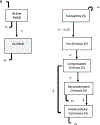Estimating the impact of a police education program on hepatitis C virus transmission and disease burden among people who inject drugs in Tijuana, Mexico: A dynamic modeling analysis
- PMID: 37039246
- PMCID: PMC10524658
- DOI: 10.1111/add.16203
Estimating the impact of a police education program on hepatitis C virus transmission and disease burden among people who inject drugs in Tijuana, Mexico: A dynamic modeling analysis
Abstract
Background and aims: Criminalization of drug use and punitive policing are key structural drivers of hepatitis C virus (HCV) risk among people who inject drugs (PWID). A police education program (Proyecto Escudo) delivering training on occupational safety together with drug law content was implemented between 2015 and 2016 in Tijuana, Mexico, to underpin drug law reform implementation. We used data from a longitudinal cohort of PWID in Tijuana to inform epidemic modeling and assess the long-term impact of Escudo on HCV transmission and burden among PWID in Tijuana.
Methods: We developed a dynamic, compartmental model of HCV transmission and incarceration among PWID and tracked liver disease progression among current and former PWID. The model was calibrated to data from Tijuana, Mexico, with 90% HCV seroprevalence. We used segmented regression analysis to estimate impact of Escudo on recent incarceration among an observational cohort of PWID. By simulating the observed incarceration trends, we estimated the potential impact of the implemented (2-year reduction in incarceration) and an extended (10-year reduction in incarceration) police education program over a 50-year follow-up (2016-2066) on HCV outcomes (incidence, cirrhosis, HCV-related deaths and disability adjusted life-years averted) compared with no intervention.
Results: Over the 2-year follow-up, Proyecto Escudo reduced HCV incidence among PWID from 21.5 per 100 person years (/100py) (95% uncertainty interval [UI] = 15.3-29.7/100py) in 2016 to 21.1/100py (UI = 15.0-29.1/100py) in 2018. If continued for 10 years, Escudo could reduce HCV incidence to 20.0/100py (14.0-27.8/100py) by 2026 and avert 186 (32-389) new infections, 76 (UI = 12-160) cases of cirrhosis and 32 (5-73) deaths per 10 000 PWID compared with no intervention over a 50-year time horizon.
Conclusions: In Tijuana, Mexico, implementation of a police education program delivering training on occupational safety and drug law content appears to have reduced hepatitis C virus incidence among people who inject drugs.
Keywords: Epidemic modelling; HCV; PWID; Tijuana; incarceration; police education.
© 2023 Society for the Study of Addiction.
Conflict of interest statement
Figures






Similar articles
-
Cost-effectiveness of a police education program on HIV and overdose among people who inject drugs in Tijuana, Mexico.Lancet Reg Health Am. 2024 Feb 1;30:100679. doi: 10.1016/j.lana.2024.100679. eCollection 2024 Feb. Lancet Reg Health Am. 2024. PMID: 38327278 Free PMC article.
-
Modelling the contribution of incarceration and public health oriented drug law reform to HCV transmission and elimination among PWID in Tijuana, Mexico.Int J Drug Policy. 2022 Dec;110:103878. doi: 10.1016/j.drugpo.2022.103878. Epub 2022 Oct 12. Int J Drug Policy. 2022. PMID: 36242829 Free PMC article.
-
Cost-effectiveness of hepatitis C virus (HCV) elimination strategies among people who inject drugs (PWID) in Tijuana, Mexico.Addiction. 2021 Oct;116(10):2734-2745. doi: 10.1111/add.15456. Epub 2021 Mar 22. Addiction. 2021. PMID: 33620750 Free PMC article.
-
Incarceration history and risk of HIV and hepatitis C virus acquisition among people who inject drugs: a systematic review and meta-analysis.Lancet Infect Dis. 2018 Dec;18(12):1397-1409. doi: 10.1016/S1473-3099(18)30469-9. Epub 2018 Oct 29. Lancet Infect Dis. 2018. PMID: 30385157 Free PMC article.
-
Hepatitis C Reinfection in People Who Inject Drugs in Resource-Limited Countries: A Systematic Review and Analysis.Int J Environ Res Public Health. 2020 Jul 9;17(14):4951. doi: 10.3390/ijerph17144951. Int J Environ Res Public Health. 2020. PMID: 32659974 Free PMC article.
Cited by
-
Cost-effectiveness of a police education program on HIV and overdose among people who inject drugs in Tijuana, Mexico.Lancet Reg Health Am. 2024 Feb 1;30:100679. doi: 10.1016/j.lana.2024.100679. eCollection 2024 Feb. Lancet Reg Health Am. 2024. PMID: 38327278 Free PMC article.
References
-
- Degenhardt L, Peacock A, Colledge S, Leung J, Grebely J, Vickerman P, et al. Global prevalence of injecting drug use and sociodemographic characteristics and prevalence of HIV, HBV, and HCV in people who inject drugs: a multistage systematic review. Lancet Glob Health. 2017;5(12):e1192–e207. - PMC - PubMed
-
- Grebely J, Dore GJ. Can hepatitis C virus infection be eradicated in people who inject drugs? Antiviral Research. 2014;104:62–72. - PubMed
-
- Graham CS, Swan T. A path to eradication of hepatitis C in low- and middle-income countries. Antiviral Research. 2015;119:89–96. - PubMed
Publication types
MeSH terms
Grants and funding
LinkOut - more resources
Full Text Sources
Medical

